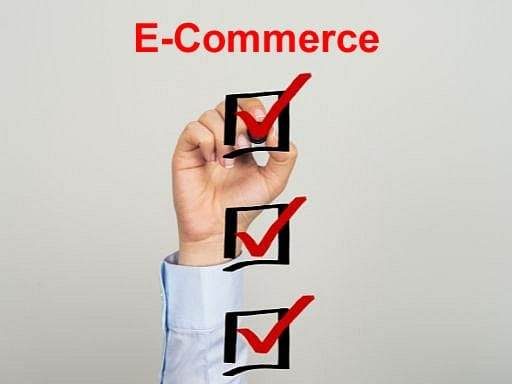Main Links

Last Updated February 25, 2025
 An eCommerce checklist is a handy tool that entrepreneurs and businesses can use to make sure they have everything they need to get their online store up and running. Having a checklist in place makes it easy to make sure you haven't forgotten any important steps when launching your online store.
An eCommerce checklist is a comprehensive list of tasks and requirements that should be undertaken in order to ensure a successful launch of any eCommerce website. It consists of all the necessary steps to get the website up and running, as well as the necessary steps to maintain and improve the site.
An eCommerce checklist typically includes items such as setting up a domain name, registering a company, setting up a hosting account, and selecting an eCommerce platform. It also includes tasks such as creating a logo, setting up payment gateways, customizing the website design, creating product pages, setting up shipping services, setting up customer service policies, and more.
By following an eCommerce checklist, businesses can ensure they have all the necessary components in place and that their eCommerce website is ready to go.
An eCommerce checklist is a handy tool that entrepreneurs and businesses can use to make sure they have everything they need to get their online store up and running. Having a checklist in place makes it easy to make sure you haven't forgotten any important steps when launching your online store.
An eCommerce checklist is a comprehensive list of tasks and requirements that should be undertaken in order to ensure a successful launch of any eCommerce website. It consists of all the necessary steps to get the website up and running, as well as the necessary steps to maintain and improve the site.
An eCommerce checklist typically includes items such as setting up a domain name, registering a company, setting up a hosting account, and selecting an eCommerce platform. It also includes tasks such as creating a logo, setting up payment gateways, customizing the website design, creating product pages, setting up shipping services, setting up customer service policies, and more.
By following an eCommerce checklist, businesses can ensure they have all the necessary components in place and that their eCommerce website is ready to go.
 When designing your eCommerce website, make sure to consider the website layout and design. Think of the user experience when setting up your website - is the navigation intuitive?
Are images and fonts optimized for all devices? Are there any potential barriers to entry for customers? By following an eCommerce website checklist, you can ensure that your website design and layout are optimized to create a great user experience.
When it comes to website design and layout, it’s important to consider the aesthetics of the website. Make sure the colors, fonts, and images you choose create a consistent and pleasing look.
Additionally, consider the layout of the website. Is the content organized into sections that make sense? Are there any elements that could be distracting or difficult to locate?
By following an eCommerce website checklist and considering the user experience, and website design, you can ensure that your website creates an enjoyable and successful shopping experience for customers.
When designing your eCommerce website, make sure to consider the website layout and design. Think of the user experience when setting up your website - is the navigation intuitive?
Are images and fonts optimized for all devices? Are there any potential barriers to entry for customers? By following an eCommerce website checklist, you can ensure that your website design and layout are optimized to create a great user experience.
When it comes to website design and layout, it’s important to consider the aesthetics of the website. Make sure the colors, fonts, and images you choose create a consistent and pleasing look.
Additionally, consider the layout of the website. Is the content organized into sections that make sense? Are there any elements that could be distracting or difficult to locate?
By following an eCommerce website checklist and considering the user experience, and website design, you can ensure that your website creates an enjoyable and successful shopping experience for customers.
 Creating standard pages on your eCommerce website is essential for success. Before you launch your site, make sure you have the necessary pages such as home, product, about, contact, and returns.
This checklist will help ensure that your online store is prepped for success by providing you with a comprehensive list of what's needed for a successful launch. Creating standard pages on your eCommerce website is essential for providing customers with the information they need to make informed decisions about their purchases.
A comprehensive list of standard pages should include:
1. Homepage: The homepage should be the first page customers see when visiting your website. It should be simple and inviting, containing product images, descriptions, and calls to action.
2. Product: This page should show off your products and provide detailed information about them, such as pricing, descriptions, and images. Customers should be able to easily navigate the product page and find what they need.
3. About: The “About Us” page should provide visitors with information about your company, such as its mission, values, and history.
4. Contact: This page should provide customers with an easy way to get in touch with you, such as an email address or contact form.
5. Returns: This page should outline your return policy, including any terms and conditions that customers must abide by when returning an item.
Taking the time to create these pages will help ensure that customers have a positive experience when shopping on your website.
Creating standard pages on your eCommerce website is essential for success. Before you launch your site, make sure you have the necessary pages such as home, product, about, contact, and returns.
This checklist will help ensure that your online store is prepped for success by providing you with a comprehensive list of what's needed for a successful launch. Creating standard pages on your eCommerce website is essential for providing customers with the information they need to make informed decisions about their purchases.
A comprehensive list of standard pages should include:
1. Homepage: The homepage should be the first page customers see when visiting your website. It should be simple and inviting, containing product images, descriptions, and calls to action.
2. Product: This page should show off your products and provide detailed information about them, such as pricing, descriptions, and images. Customers should be able to easily navigate the product page and find what they need.
3. About: The “About Us” page should provide visitors with information about your company, such as its mission, values, and history.
4. Contact: This page should provide customers with an easy way to get in touch with you, such as an email address or contact form.
5. Returns: This page should outline your return policy, including any terms and conditions that customers must abide by when returning an item.
Taking the time to create these pages will help ensure that customers have a positive experience when shopping on your website.
 Designing the shopping cart page of your eCommerce website is an essential part of the customer experience. Make sure you provide an intuitive user interface, easy navigation, and a secure checkout process.
Additionally, consider adding options such as coupon codes, loyalty programs, and gift cards to help create a more enjoyable shopping experience. When designing a shopping cart page, it is important to create a user-friendly experience for customers.
This means making sure the page is easy to navigate and that the checkout process is secure. Additionally, make sure all relevant product information is displayed clearly and accurately. This includes product images, descriptions, and pricing.
Make sure to include a “proceed to checkout” button that is clearly visible and easily accessible. This will make it easy for customers to complete their purchases.
You can also provide customers with the option to save their cart for later or to add items to a wishlist. Additionally, adding options such as gift cards can help to create a more enjoyable shopping experience.
Finally, make sure to include a customer feedback form or support page. This will allow customers to provide feedback on their experience and help improve the overall design of your shopping cart page.
Designing the shopping cart page of your eCommerce website is an essential part of the customer experience. Make sure you provide an intuitive user interface, easy navigation, and a secure checkout process.
Additionally, consider adding options such as coupon codes, loyalty programs, and gift cards to help create a more enjoyable shopping experience. When designing a shopping cart page, it is important to create a user-friendly experience for customers.
This means making sure the page is easy to navigate and that the checkout process is secure. Additionally, make sure all relevant product information is displayed clearly and accurately. This includes product images, descriptions, and pricing.
Make sure to include a “proceed to checkout” button that is clearly visible and easily accessible. This will make it easy for customers to complete their purchases.
You can also provide customers with the option to save their cart for later or to add items to a wishlist. Additionally, adding options such as gift cards can help to create a more enjoyable shopping experience.
Finally, make sure to include a customer feedback form or support page. This will allow customers to provide feedback on their experience and help improve the overall design of your shopping cart page.
 When setting up an eCommerce website, it is important to make sure that you have integrated secure payment methods. This should include both credit cards and electronic payments, such as PayPal or Apple Pay.
Having a wide range of payment options will help ensure that customers feel safe and comfortable when making purchases on your site. When integrating payment methods into your eCommerce website, it is important to choose secure and reliable payment gateways.
This is critical to ensuring that customer data is safe and secure. It's also important to consider how customers will be able to view and pay their bills.
Will they be able to access their bills online, or will they need to use a separate payment method? Additionally, it is important to consider how you will handle refunds and cancellations.
You will need to make sure that you have a system in place that allows customers to easily and quickly receive refunds when necessary. Finally, you should be aware of any applicable laws or regulations that might affect the way you handle payments.
When setting up an eCommerce website, it is important to make sure that you have integrated secure payment methods. This should include both credit cards and electronic payments, such as PayPal or Apple Pay.
Having a wide range of payment options will help ensure that customers feel safe and comfortable when making purchases on your site. When integrating payment methods into your eCommerce website, it is important to choose secure and reliable payment gateways.
This is critical to ensuring that customer data is safe and secure. It's also important to consider how customers will be able to view and pay their bills.
Will they be able to access their bills online, or will they need to use a separate payment method? Additionally, it is important to consider how you will handle refunds and cancellations.
You will need to make sure that you have a system in place that allows customers to easily and quickly receive refunds when necessary. Finally, you should be aware of any applicable laws or regulations that might affect the way you handle payments.